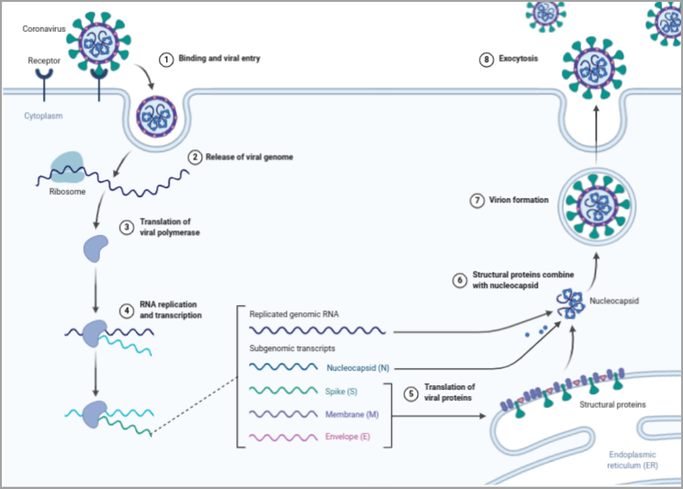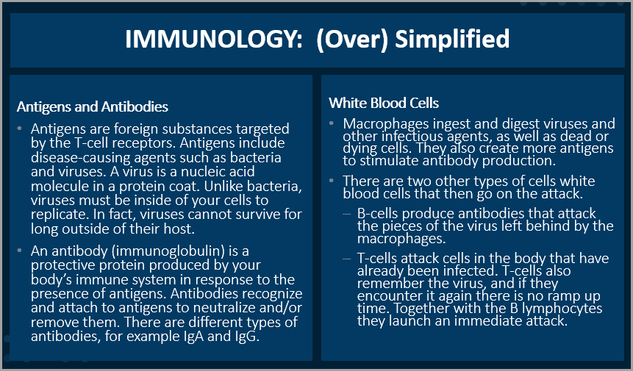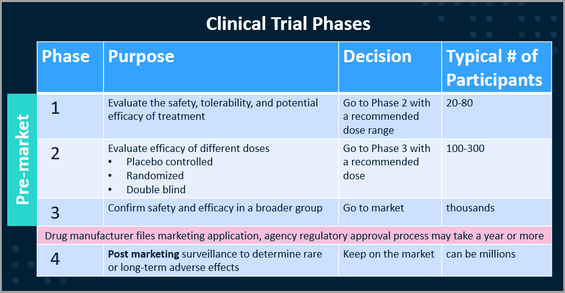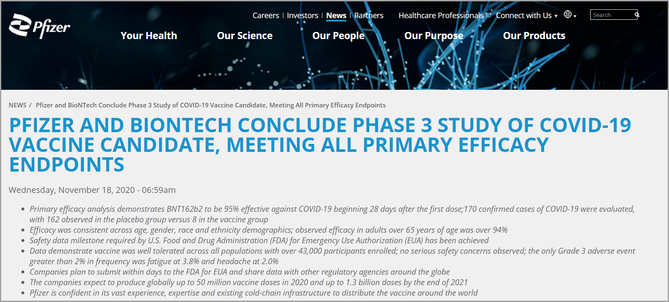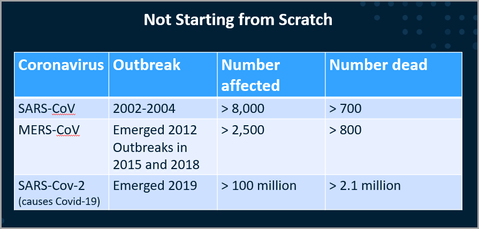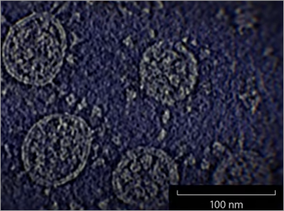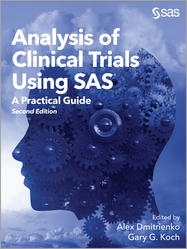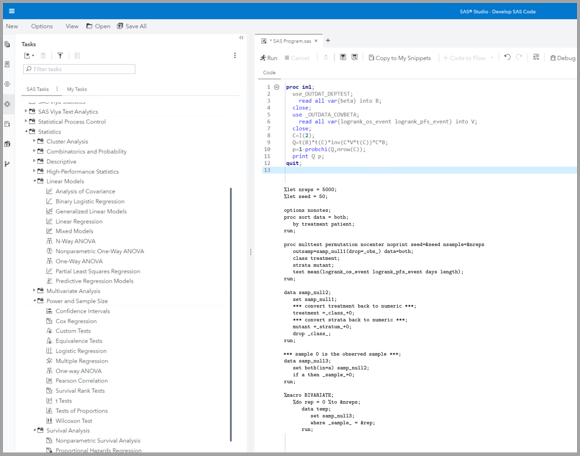- Home
- /
- SAS Communities Library
- /
- Vaccine Efficacy, Clinical Trials, and SAS: Part 4 of Biostats in the ...
- RSS Feed
- Mark as New
- Mark as Read
- Bookmark
- Subscribe
- Printer Friendly Page
- Report Inappropriate Content
Vaccine Efficacy, Clinical Trials, and SAS: Part 4 of Biostats in the Time of Coronavirus
- Article History
- RSS Feed
- Mark as New
- Mark as Read
- Bookmark
- Subscribe
- Printer Friendly Page
- Report Inappropriate Content
As the vaccine is rolled out in countries throughout the world, many people have questions about the safety and efficacy of the new COVID-19 vaccine. What you may not know is that SAS has been the de facto standard for biostatistics, drug testing, and clinical trials in many regions since the 1970s. In this article I'll talk a bit about vaccines in specific, then clinical trials in general, and finally I’ll direct you to resources that help you take advantage of the power of SAS in conducting clinical trials.
How Do Vaccines Work?
To understand vaccines and how they work we must first understand a bit about the human body’s immune system and how it fights diseases.
When viruses, such as the coronavirus, invade your body, their primary goal is to enter your cells and replicate themselves.
http://www.sciencedirect.com/topics/medicine-and-dentistry/memory-b-cell
Select any image to see a larger version.
Mobile users: To view the images, select the "Full" version at the bottom of the page.
Some viruses you may not even notice. Others wreak havoc. Your immune system responds by fighting back. White blood cells in particular fight against a virus or other disease agent.
The first time you are infected with a virus that your immune system hasn’t seen before, it can take days or weeks for your immune system to mount an attack. If It takes too long your body may be so damaged that you don't recover. The good news is that a key feature of your immune response is MEMORY. If you have a healthy immune system, the second time it sees that same virus it is already prepared. It is not no longer caught unawares and does not need a long time to mount a response; it begins its attack immediately. So how do vaccines work, you're wondering. Although each vaccine is a little bit different, in general they work by giving you a weakened version of the virus or pieces of the virus. This lets your immune system prepare its attack response. Thus, it will launch an instant attack should you ever encounter the actual virus. So probably when you do encounter the actual virus you do not actually get very sick. Because your body is already immune. For more details see the CDC web site here and here.
Unfortunately, however, no vaccine is 100% effective. One of the most effective vaccines, the measles/mumps/rubella (MMR) vaccine, is up to 99% effective. That means for every hundred individuals who get the two dose MMR vaccine one of those individuals will unfortunately not be protected. However, the good news is that if everyone is vaccinated then only 1% of the population is vulnerable and it's much more unlikely that they will encounter someone with measles. So even those without immunity may receive some protection via herd immunity.
Some vaccines require repeated doses to fully enabled your immune system to prepare for attack. For example the Pfizer vaccine for COVID-19 requires two doses separated by 21 days.
Many vaccines are effective for years. However, some vaccines require booster shots over time. Your vaccine may become ineffective overtime because:
- Your immune system changes, or
- The virus or bacteria has evolved or changed
Clinical Trials
Before any drug or vaccine can go to market it must be determined to be both safe and effective. Most countries have an agency that oversees this process. Here is a list of some of the most populous countries and their agency that oversees drugs and vaccines.
Before clinical trials even start there is generally a discovery and preclinical testing phase that commonly includes laboratory studies and animal studies. The goal of this phase is to learn about the pharmacokinetics and pharmacodynamics of the drug, possible side effects and toxicity, and to try to correct early absorption and toxicity problems.
In the United States the Federal Drug Administration (FDA) is the organization that oversees the clinical trial process. Below this four phase process for the United States is highlighted. Many countries have a similar process.
Statistical analyses may use a dose response modeling approach or it may use pairwise comparisons (with, for example, ANOVA and t-tests). For details see this article.
So how were clinical trials for the COVID-19 vaccine able to go to market in less than a year, you might ask. I asked myself that question also.
There are at least 3 parts to this answer:
- Scientists had studied other coronaviruses already
- The direness of the emergency has prompted regulatory agencies provide emergency authorizations to try to save lives
- Some pharmaceutical companies took a gamble and started production before approval
One part of the answer lies in the fact that this novel coronavirus is not the first coronavirus studied. Other coronaviruses like SARS and MERS have been around for a while and have been studied. SARS was discovered in February 2003 and the first known case of MERS was in April 2012. Although no effective vaccine had been approved for the prevention of human coronavirus infections when COVID-19 landed on the scene, the scientific body of knowledge on pathogenic coronaviruses has been increasing over the last two decades.
Seven genera of coronaviruses infect humans. Four of these cause relatively mild symptoms. The other three can lead to severe respiratory diseases and sometimes death. These are Severe Acute Respiratory Syndrome Coronavirus (SARS-CoV), Middle East Respiratory Syndrome Coronavirus (MERS-CoV), and finally Severe Acute Respiratory Syndrome Coronavirus 2 (SARS-CoV-2), which causes the disease known as COVID-19.
Corona means crown in Latin. Coronaviruses got the name from crown-like appearance under the electron microscope as you can faintly see in the image below.
It's easy to see how these protrusions from the coronavirus resemble a crown, as pictured below.
A second reason that COVID-19 vaccines have been approved so quickly is because of the worldwide pandemic. As of 27 January 2021, there have been more than 100 million COVID-19 cases of and more than 2.1 million COVID-19 deaths worldwide. Another 15,000 people died yesterday from COVID-19.
This worldwide emergency has caused the drug regulating agencies to provide emergency approval for some COVID-19 vaccines. In the United States, for example, the FDA has provided Emergency Use Authorization (EUA) for some COVID-19 vaccines and has begun vaccinations. Unfortunately vaccine supply is very limited right now, and there are more people seeking vaccines then there are vaccines available in the United States.
A third reason that vaccines have been ready so quickly is that some pharmaceutical companies took a financial gamble by starting to produce their vaccines even before the vaccine was approved. This is a financial gamble because if the vaccine is not approved, they will have wasted money and resources on the large production of something that would just have to be thrown away. Typically drug companies do not purchase raw materials, create manufacturing lines, or establish supply chains for shipment until after a vaccine has been approved. For the COVID-19 vaccine some pharmaceutical companies did all of these things simultaneously, which is unprecedented in recent history.
Clinical Trials with SAS
SAS has been used as part of the process of conducting clinical trials since the early 70s. The following books are good resources providing information on using SAS for clinical trials.
SAS also provides a certification program Extended Learning - SAS Certified Clinical Trials Programmer (EXSACP3)
And remember, in addition to writing SAS code, SAS tasks are available in SAS Studio to build the code for you. See my YouTube video to learn more about SAS Studio tasks.
COVID-19 Vaccine Shortage
Despite the efforts to ramp up as quickly as possible, The demand for vaccines far exceeds the availability. This is in part because production is not fully ramped up and it is exacerbated by supply chain issues. There are shortfalls of raw materials to create the vaccines as well as items needed to ship and administer the vaccine. For example, dry ice is in short supply and so on.
And yes! SAS can also help with supply chain issues with our supply chain analytics and optimization. But that's an article for another day.
For more information
- 2018. Venky Chakravarthy. The Anatomy of Clinical Trials Data: A Beginner’s Guide SGF Paper 1759-201...
- 2020. Yen-Der Li, Wei-Yu Chi, Jun-Han Su, Louise Ferrall, Chien-Fu Hung & T.-C. Wu. Coronavirus vacc...
- 2010. Jose Pinheiro at al. Adaptive and Model-Based Dose-Ranging Trials: Quantitative Evaluation and...
- Pfizer vaccine info: one, two, three.
- How SAS has Impacted History.

The 2025 SAS Hackathon has begun!
It's finally time to hack! Remember to visit the SAS Hacker's Hub regularly for news and updates.
SAS AI and Machine Learning Courses
The rapid growth of AI technologies is driving an AI skills gap and demand for AI talent. Ready to grow your AI literacy? SAS offers free ways to get started for beginners, business leaders, and analytics professionals of all skill levels. Your future self will thank you.
- Find more articles tagged with:
- COVID-19 biostats
- GEL
